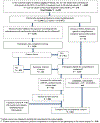Vision outcomes in children with fetal alcohol spectrum disorders
- PMID: 37461259
- PMCID: PMC10862690
- DOI: 10.1002/bdr2.2223
Vision outcomes in children with fetal alcohol spectrum disorders
Abstract
Background: Previous studies demonstrated that children with Fetal Alcohol Spectrum Disorders (FASD) are more likely to have vision impairments. However, existing human clinical and epidemiological investigations are few and include limited sample sizes. This study aimed to explore the association between ophthalmologic abnormalities and FASD in a sample of 5-7 year old children in the general population.
Methods: This was a cross-sectional study nested in a larger study intended to estimate the prevalence of FASD in San Diego, California, conducted between 2012 and 2014. Prenatal exposure to alcohol, dysmorphology examinations, and a neurobehavioral testing battery were collected for each child and an FASD diagnosis was assigned. Parents of participating children were asked to release their child's vision screening or diagnostic records.
Results: Vision records were obtained for 424 participants in the larger prevalence study. Of these, 53 children were classified as having FASD. A statistically significant association was found between FASD and a diagnosis of strabismus; 5/42 (11.9%) of children who were classified as having FASD had strabismus compared to 6/290 (2.1%) of children who were not classified as having FASD (p = .01). All five cases of strabismus in the FASD group occurred in 19 children classified as having partial fetal alcohol syndrome (pFAS). No association was found between FASD and vision impairment (p = .23), refractive errors (p = .66), glasses/contact lens prescription (p = .30), or having one or more ophthalmological abnormalities (p = .97).
Conclusions: An association between strabismus and FASD, specifically partial FAS, suggests that the effect of alcohol exposure on risk of strabismus must be severe enough to result in facial features consistent with FASD. This emphasizes the importance of vision screening in children with FASD.
Keywords: alcohol; fetal alcohol spectrum disorders; pregnancy; vision.
© 2023 The Authors. Birth Defects Research published by Wiley Periodicals LLC.
Conflict of interest statement
CONFLICT OF INTEREST STATEMENT
The authors declare no conflicts of interest.
Similar articles
-
Fetal alcohol spectrum disorders in Finland: clinical delineation of 77 older children and adolescents.Am J Med Genet A. 2006 Jan 15;140(2):137-43. doi: 10.1002/ajmg.a.31037. Am J Med Genet A. 2006. PMID: 16353236
-
Fetal alcohol spectrum disorders and access to regional center services in San Diego County.Alcohol Clin Exp Res. 2022 Oct;46(10):1857-1864. doi: 10.1111/acer.14934. Epub 2022 Sep 14. Alcohol Clin Exp Res. 2022. PMID: 36059261 Free PMC article.
-
Epidemiology of FASD in a province in Italy: Prevalence and characteristics of children in a random sample of schools.Alcohol Clin Exp Res. 2006 Sep;30(9):1562-75. doi: 10.1111/j.1530-0277.2006.00188.x. Alcohol Clin Exp Res. 2006. PMID: 16930219
-
Updated Clinical Guidelines for Diagnosing Fetal Alcohol Spectrum Disorders.Pediatrics. 2016 Aug;138(2):e20154256. doi: 10.1542/peds.2015-4256. Epub 2016 Jul 27. Pediatrics. 2016. PMID: 27464676 Free PMC article.
-
A review of the physical features of the fetal alcohol spectrum disorders.Eur J Med Genet. 2017 Jan;60(1):55-64. doi: 10.1016/j.ejmg.2016.10.004. Epub 2016 Oct 10. Eur J Med Genet. 2017. PMID: 27729236 Review.
Cited by
-
A Mendelian randomization study on the causal relationship between smoking, alcohol consumption, and the development of myopia and astigmatism.Sci Rep. 2024 Jan 22;14(1):1868. doi: 10.1038/s41598-024-52316-9. Sci Rep. 2024. PMID: 38253641 Free PMC article.
-
Beyond the Brain: The Physical Health and Whole-Body Impact of Fetal Alcohol Spectrum Disorders.Alcohol Res. 2025 Jun 12;45(1):05. doi: 10.35946/arcr.v45.1.05. eCollection 2025. Alcohol Res. 2025. PMID: 40525081 Free PMC article. Review.
References
-
- Autti-Rämö I, Fagerlund A, Ervalahti N, Loimu L, Korkman M, & Hoyme HE (2006). Fetal alcohol spectrum disorders in Finland: Clinical delineation of 77 older children and adolescents. American Journal of Medical Genetics. Part A, 140, 137–143. - PubMed
-
- Bertrand J, Floyd RL, Weber MK, O’Connor M, Riley EP, Johnson KA, Cohen DE, & National Task Force on FAS/-FAE. (2004). Fetal alcohol syndrome: Guidelines for referral and diagnosis. Centers for Disease Control and Prevention.
-
- Castejon OC, Gonzalez I, Prieto E, Perez T, Pablo LE, & Pueyo V (2019). Visual cognitive impairments in children at risk of prenatal alcohol exposure. Acta Paediatrica, 108, 2222–2228. - PubMed
-
- Elliott EJ, Payne J, Morris A, Haan E, & Bower C (2008). Fetal alcohol syndrome: A prospective national surveillance study. Archives of Disease in Childhood, 93(9), 732–737. - PubMed
-
- Genetic Alliance, The New England Public Health Genetics Education Collaborative (2010). Appendix a teratogens/prenatal substance abuse. In understanding genetics: A New England guide for patients and health professionals (pp. 68–69). Genetic Alliance. - PubMed
Publication types
MeSH terms
Grants and funding
LinkOut - more resources
Full Text Sources
Medical
Research Materials
Miscellaneous


